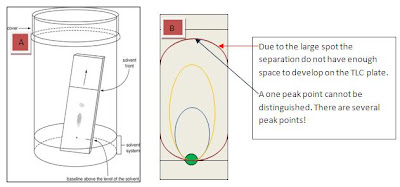Procedure of Thin Layer Chromatography
Thin
layer chromatography (TLC) plate is prepared by application of a uniform layer
of adsorbent on to a glass or an Aluminum plate. The application of the
adsorbent can be done by pouring the slurry, spraying the suspension and use of
commercial applicators. The slurry is made by dissolving SiO2 in
water. Also there are readymade TLC plates available in shops.
Then
this plate should be heated at 1000C -1050C for 30
minutes in an oven. This is to activate the plate and this activation should be
done before the sample is loaded. There after the sample is loaded. When the
sample is loading we must be sure to spot the sample several times in order to
obtain a concentrated spot. But the diameter of the spot should not be exceeded
2mm. If the spot is large, then during the separation the lines of the compound
will be not limited to the plate (B). And also if the spot is big and dilute then
a peak of the line is difficult to observe. Then the plate is inserted into the
tank where the mobile phase solvent is present (A). After the development of
the chromatogram the compounds are located. Locating spots are similar as discussed in the paper
chromatography section. The use of strong acids ex: H2SO4
and exposing to relatively high temperatures are two methods of locating spots
which are specific to TLC. Exposing to high temperature occur cracks in the
glass solid support. Hence this location technique is suitable for Al solid
supports.



Comments
Post a Comment